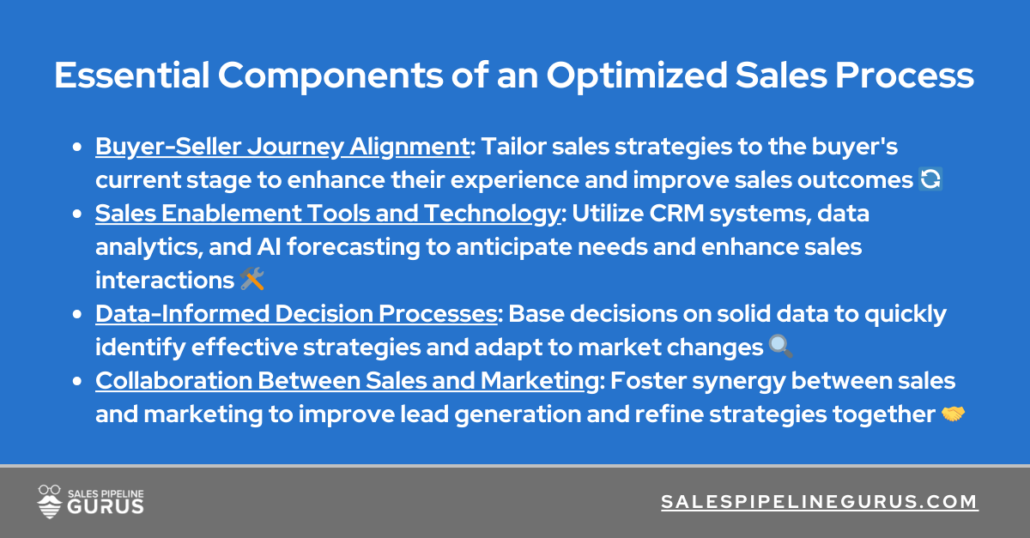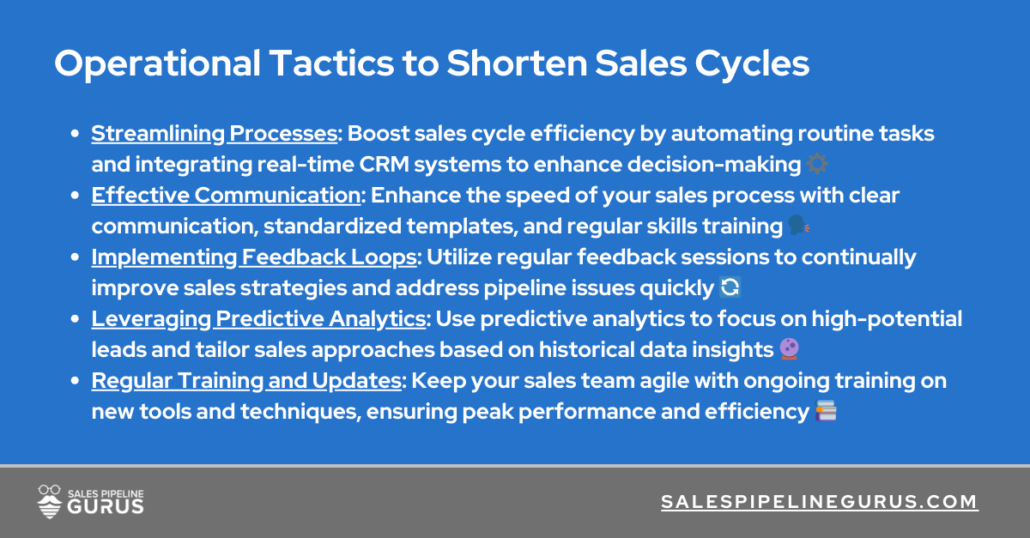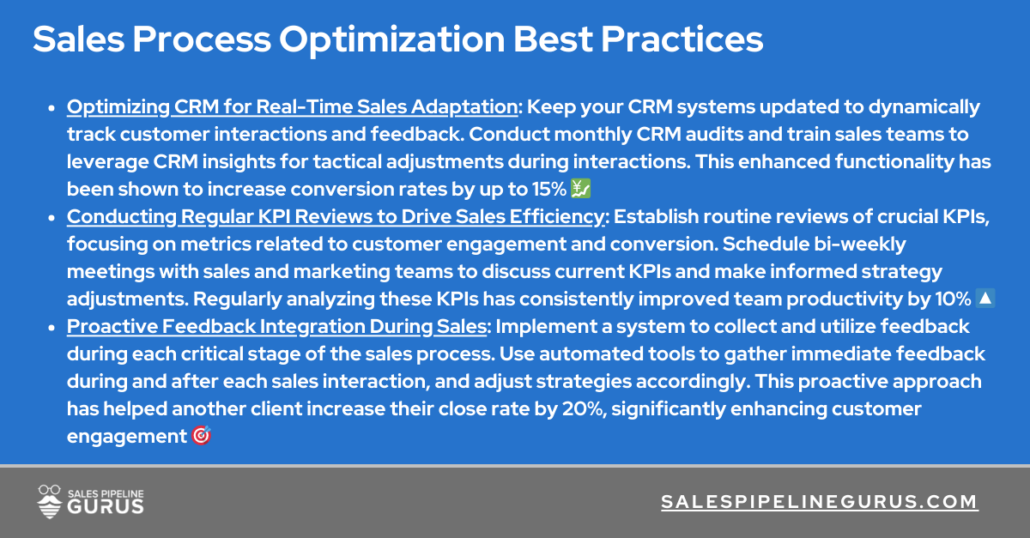Sales Process Optimization in 2024: The Ultimate Guide

Have you ever wondered how some companies manage to significantly boost their sales figures within a short period? Take a typical mid-sized tech firm in Silicon Valley, for example. Despite offering top-notch solutions, their growth was stagnant. Then, they focused on fine-tuning their sales process and saw a 30% increase in revenue in just one year. Stories like this are becoming more common and demonstrate the power of effective sales process optimization.
This guide is designed to help you understand and implement similar changes. By refining each step of your sales process, you can not only increase your team’s efficiency but also significantly improve their effectiveness. Whether you’re dealing with the integration of new technologies, shifting to digital markets, or just trying to enhance overall performance, this guide will provide you with straightforward insights and actionable strategies. You’ll learn how to optimize your sales process to achieve better results in today’s competitive environment.
Ready to see how? Let’s dive in.
Table of Contents:
- Understanding Sales Process Optimization
- Essential Components of an Optimized Sales Process
- Strategies to Enhance the Sales Process
- Operational Tactics to Shorten Sales Cycles
- Monitoring and Adjusting Through KPIs
- Real-World Examples and Best Practices
- Conclusion
1. Understanding Sales Process Optimization
Definition and Significance
What exactly is sales process optimization? It’s about refining each step from the initial contact with a prospect to closing a deal to ensure maximum efficiency. Imagine a scenario where a sales team reduces the time spent on each call by 10%, simply by using better qualifying questions. This small change can lead to quicker sales cycles and more deals closed over time, demonstrating how crucial optimization is, especially in competitive fields like B2B technology and business services.
Market Challenges
In today’s fast-paced market, businesses face numerous hurdles that can slow down sales. Adapting to digital markets, integrating cutting-edge technologies, and understanding complex customer needs are common challenges. A well-optimized sales process not only helps you navigate these hurdles with greater agility but also makes your team more responsive to customer demands and market changes. For example, by implementing a CRM system that automatically updates customer preferences and histories, a sales team can quickly adjust their approaches to better meet customer expectations.
2. Essential Components of an Optimized Sales Process
Buyer-Seller Journey Alignment
It’s crucial to match your sales approach to where the buyer is in their purchasing journey. For instance, if a buyer is just learning about your product, your team should focus on educating them rather than pushing for a sale. Tailoring interactions to fit the buyer’s stage can greatly improve their experience and increase the likelihood of closing a sale.
Sales Enablement Tools and Technology
Effective sales teams leverage tools like CRM systems, data analytics platforms, and AI-driven forecasting to stay ahead. These technologies store essential customer information, analyze buying patterns, and predict sales trends. By using these tools, your team can anticipate customer needs and tailor their approaches, significantly enhancing interaction quality and effectiveness.
Data-Informed Decision Processes
Decisions driven by solid data lead to better outcomes. For example, a sales team that analyzes conversion rates from various strategies can quickly identify the most effective tactics and scale them up. This not only boosts efficiency but also ensures the team remains adaptable to market and customer changes.
Collaboration Between Sales and Marketing
When sales and marketing teams work closely, they create a powerful synergy that enhances the entire customer acquisition process. Marketing campaigns generate targeted leads, while sales provide feedback on customer reactions, helping to refine future marketing efforts. This collaboration results in a unified strategy that maximizes both engagement and conversions.

3. Strategies to Enhance the Sales Process
Lead Qualification and Prioritization
Maximize sales team efficiency by focusing on leads with the highest potential for conversion. Implement a scoring system to assess leads based on criteria such as industry relevance, company size, and engagement level. Prioritizing high score leads ensures that sales efforts are concentrated where they are most likely to yield results.
Personalized Training and Development
Boost your sales team’s performance with customized training programs. Identify specific areas where each salesperson can improve and provide targeted training to address these gaps. For example, a salesperson struggling with closing might benefit from a workshop on advanced closing techniques, leading to better sales outcomes.
Customized Sales Strategies and Solutions
Adapt your sales strategies to meet the distinct needs of different customer segments. Develop tailored approaches that address specific challenges and preferences of each group, such as offering industry-specific solutions or personalized product demonstrations. This customization makes your solutions more attractive and relevant to potential customers.
Effective Lead Nurturing and Follow-Up
Keep potential customers engaged with regular, meaningful follow-ups. Use a combination of emails, phone calls, and meetings to provide valuable content and updates that align with their interests. This continuous engagement helps build trust and keeps your brand top of mind, increasing the likelihood of a sale.
Simplifying and Streamlining the Sales Cycle
Reduce the complexity of your sales cycle to speed up the process from initial contact to close. Eliminate redundant steps, automate administrative tasks, and use tools that provide real-time insights to quickly adjust sales tactics. Streamlining these processes can significantly shorten the sales cycle and enhance customer experience.

4. Operational Tactics to Shorten Sales Cycles
Streamlining Processes
Efficiency is key to shortening sales cycles. For example, by automating routine tasks like data entry and customer follow-ups, sales teams can focus more on closing deals. Integrating CRM systems that sync in real-time can also remove informational bottlenecks, allowing for quicker, more informed decision-making. Start by mapping out your current sales process, identifying any redundant steps, and strategically applying automation where it impacts the most.
Effective Communication
Direct and clear communication can significantly speed up the sales process. Train your team to effectively convey value propositions and respond promptly to prospect inquiries. Implementing standardized communication templates for common questions or updates ensures consistency and saves time. Regular workshops on communication skills, like active listening, can enhance your team’s ability to address client concerns swiftly and accurately.
Implementing Feedback Loops
Constructive feedback is vital for continual improvement. Set up regular sessions where sales teams can report back on what is working and what isn’t and gather customer feedback to understand their experience better. This direct line of insight can help quickly pinpoint issues like unnecessary delays in the sales pipeline and provide actionable solutions.
Leveraging Predictive Analytics
Predictive analytics can transform how you approach potential customers. Analyze historical data to predict future buying behaviors and tailor your approach accordingly. This targeted strategy can reduce time wasted on less promising leads, focusing efforts on those with a higher likelihood to convert. Tools that support predictive analytics can provide suggestions on the best times to contact leads or offer insights into the products they are most likely to buy.
Regular Training and Updates
Ensure your sales team remains competitive by keeping them updated on new tools and techniques. Hold monthly training sessions to introduce new software and quarterly refreshers on sales best practices. Keeping your team well-equipped and informed helps them adapt to changes more quickly and keeps your sales process efficient.

5. Monitoring and Adjusting Through KPIs
Key Performance Indicators (KPIs)
Effective sales management depends on tracking key metrics that reflect the effectiveness of your sales strategies. Crucial KPIs to monitor include:
Conversion Rate
- What It Is: The percentage of leads that convert into paying customers.
- Why It’s Important: Measures the effectiveness of your sales pitch and lead quality. A high conversion rate indicates that your sales strategies are successfully meeting customer needs.
- How to Calculate: Conversion Rate (%) = (Number of Sales / Number of Leads) × 100
Average Deal Size
- What It Is: The average revenue earned from each closed deal.
- Why It’s Important: Assesses the value of sales and informs pricing strategy and product placement.
- How to Calculate: Average Deal Size = Total Revenue/Number of Deals Closed
Sales Cycle Length
- What It Is: The average duration between initial contact and closing a sale.
- Why It’s Important: Identifies process bottlenecks and efficiency issues. Shorter cycles can increase revenue opportunities and improve team productivity.
- How to Calculate: Sales Cycle Length = Average Time from First Contact to Deal Closure
Customer Retention Rate
- What It Is: The percentage of customers who continue to purchase over a given period.
- Why It’s Important: Reflects customer satisfaction and loyalty, crucial for long-term business sustainability.
- How to Calculate: Customer Retention Rate (%) = (Number of Customers at End – New Customers during Period / Number of Customers at Start) × 100
By regularly monitoring these KPIs, managers can swiftly identify trends, adjust strategies, and enhance overall sales performance.
Interpreting Metrics
Interpreting these metrics involves understanding their implications for your specific business context. For example, a sudden drop in the conversion rate might indicate a need for better lead quality or more effective sales scripts. An improvement in customer retention rate might reflect successful customer service initiatives or product enhancements.
Actionable Adjustments
For each metric, establish clear guidelines for action. If the average deal size is declining, consider strategies like up-selling or cross-selling training for the sales team. For low customer retention rates, review customer service policies and engagement efforts.
Regular Review Sessions
Incorporate regular strategy sessions to analyze these KPIs, inviting input from the sales team to foster a collaborative improvement culture. Celebrate successes to motivate the team and scrutinize shortfalls to develop immediate corrective actions.
Using Technology to Enhance Tracking
Leverage advanced CRM and analytics tools that offer detailed reports and real-time data. Highlight how specific features, such as predictive analytics or integration capabilities, can improve KPI tracking and provide strategic insights.

6. Real-World Examples and Best Practices
Explore how companies have successfully implemented sales process optimization best practices, with a focus on aligning strategies with the buyer’s journey and enhancing engagement and conversions.
Success Stories
Tech Startup’s Strategic Overhaul Leads to 40% Revenue Increase
- Background: Facing stagnant growth due to inefficient sales tactics, a tech startup struggled with a 90-day sales cycle and a low 2% conversion rate.
- Strategy Implemented: They revamped their CRM to better capture and analyze interactions at each stage of the sales process, enabling real-time adjustments aligned with the buyer’s journey.
- Outcome: The new strategy reduced the sales cycle to 60 days and improved the conversion rate to 5%, resulting in a 40% revenue increase. The sales director noted, “Aligning our approach more closely with the buyer’s journey not only improved efficiency but also enhanced customer satisfaction.”
Service Company Boosts Retention by 25% Through Enhanced Engagement
- Background: A service company noted a decrease in customer retention, with feedback pointing to a disconnect during initial sales interactions.
- Strategy Implemented: Real-time feedback integration in their CRM system allowed the sales team to immediately adjust communications and service offerings based on customer cues and preferences.
- Outcome: Adjustments made during the sales interactions significantly improved alignment with customer expectations, boosting retention rates from 70% to 95%. A key account manager shared, “Listening and adapting to customer feedback during initial interactions has been a game-changer for our retention rates.”
Learning from Best Practices
Optimizing CRM for Real-Time Sales Adaptation
- Best Practice: Regularly update CRM systems to ensure they can effectively track customer interactions and feedback in real time.
- Action Steps: Conduct monthly CRM audits to ensure data accuracy and functionality. Train sales teams on leveraging CRM insights to adjust tactics mid-interaction.
- Benefit: Enhanced CRM functionality allows for dynamic sales adjustments, which a pilot program showed could lead to a 15% increase in conversion rates.
Conducting Regular KPI Reviews to Drive Sales Efficiency
- Best Practice: Establish routine KPI reviews focusing on metrics related to customer engagement and conversion.
- Action Steps: Schedule bi-weekly meetings with sales and marketing teams to discuss current KPIs, using real-time data to make informed adjustments.
- Benefit: These sessions keep strategies aligned with market dynamics and have consistently shown a 10% improvement in team productivity.
Proactive Feedback Integration During Sales
- Best Practice: Implement a system for collecting and utilizing feedback during each critical stage of the sales process.
- Action Steps: Use automated tools to gather immediate feedback during and after each sales interaction and adjust strategies accordingly.
- Benefit: This approach has helped another client increase their close rate by 20%, as immediate adjustments based on feedback significantly improved customer engagement.

Conclusion
This sales process optimization guide has equipped you with a robust set of strategies for optimizing your sales process, each proven to enhance efficiency, boost conversion rates, and significantly improve customer retention. By aligning your sales process with the buyer’s journey, leveraging powerful CRM tools, and making data-driven decisions, your business can not only meet but exceed the evolving expectations of today’s market.
Next Steps
Transform your sales process from a static set of steps into a dynamic growth engine. Begin by conducting a thorough audit of your current practices. Identify key areas where you can apply the strategies discussed, such as enhancing lead qualification or streamlining the sales cycle.
Take our AI-driven sales performance assessment to learn more about the gaps and areas for sales process optimization. This assessment will provide you with a detailed analysis of your current strategies and pinpoint opportunities for improvement.
If you’ve found value in this guide, share it to extend its reach and impact. Help others discover these powerful techniques to enhance their sales processes and achieve greater success.
Remember, the journey to sales excellence is ongoing and requires a proactive stance on learning and adaptation.

